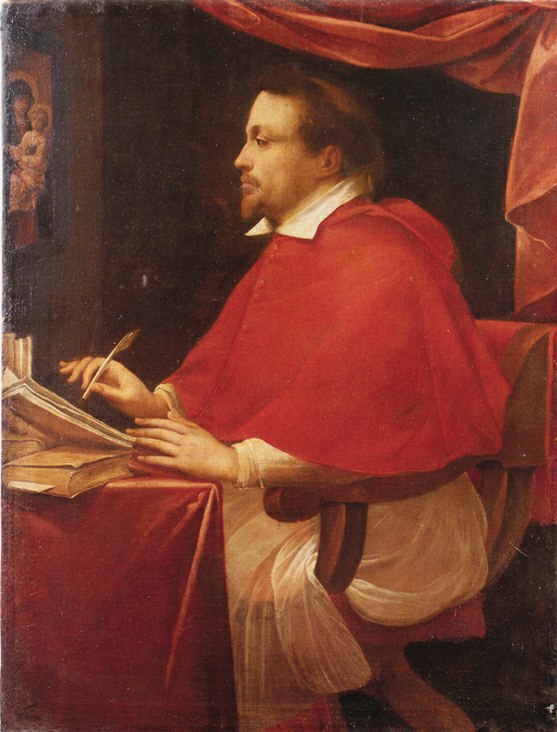Federico Borromeo
1564–1631
PatronCardinal/prelate
Federico Borromeo was born in Milan in 1564 to Margherita Trivulzio and Count Giulio Cesare Borromeo. Upon his father’s death in 1572, he was placed under the custody of his older cousin, Carlo Borromeo. Carlo, then the Archbishop of Milan, wanted Federico to have an ecclesiastical career. He enrolled the young Borromeo in the Studio di Bologna and later at the Collegio Borromeo, where Federico was educated as a humanist. During his time in Bologna, he became interested the Jesuit religious order and, although Carlo did not allow him to join, he remained a deeply faithful man throughout his life. After Carlo’s death in 1584, Federico was pressured by their family to follow in his cousin’s footsteps by obtaining a political position within the church. He moved to Rome in 1586, where he would live for the next fifteen years, and was named a Cardinal by Pope Sixtus V in 1587. He remained in this position until Clement VIII appointed him Archbishop of Milan in 1595. In 1601, at thirty- seven years old, Federico moved to Milan permanently. As Archbishop, he was known to be heavily involved within his own diocese, which included overseeing reforms decreed by the Council of Trent. He lived in Milan until his death in 1631.
Federico’s spirituality developed fully during his time in Rome and remained with him throughout his life. In particular, he subscribed to what is known as “Christian optimism,” the belief that all things created by God, whether animate or inanimate, are essentially good. Borromeo especially believed that God’s physical creations and gifts were all that was necessary to save humanity. Thus the study of physical nature was enough to lead one to a contemplation of the divine and spiritual.
His interest in finding spirituality in the physical eventually led Borromeo to the art world during his time in Rome. He began as a Cardinal Protector of the Accademia di San Luca in 1593 and continued to support art throughout his life. Borromeo believed visual art could be used as an aid in devotional prayer and also as a stimulant of spirituality. The culmination of this belief was the foundation of the Ambrosiana in Milan in 1607. It was an institution that consisted of a library, art museum, and art academy, and that aimed to bring together Christian scholarship and the visual arts. The academy especially focused on training artists to create works that followed the decrees of the Council of Trent. When it opened the library had around 30,000 printed books and 15,000 manuscripts while the art museum had 172 paintings. The Ambrosiana is still in operation today, and its archive contains many manuscript letters from Brueghel to his patron.
Jan Brueghel the Elder was one of Borromeo’s favorite contemporary artists. The two men probably met in Rome in 1593 and Borromeo soon began to commission works by the painter, continuing to be a patron for the rest of his life. Borromeo was especially taken with Brueghel’s landscapes and still lifes. He acquired his first work, Landscape with a Hermit Reading and Ruins, in 1596 and his second shortly thereafter in 1597. Borromeo’s fascination with landscapes arose from his Christian optimist beliefs. Nature was a way to become closer to God, because He could be found in all that He had created. Paintings of nature could substitute as an object of spiritual contemplation during the winter or in an urban environment. Brueghel probably traveled to Milan in his patron’s company when Borromeo moved there, although he stayed with him only for a few months. After Brueghel’s return to Antwerp, Borromeo continued to obtain paintings from him. Most famously, it was at Borromeo’s suggestion that Brueghel developed the genre of flower garlands around devotional images of the Virgin Mary, with collaborators Van Balen or Rubens executing the central imagery. Borromeo made it clear that Brueghel’s garland was the greater source of spiritual fulfillment. Borromeo would eventually own twenty-nine works by Brueghel that now hang in the Ambrosiana Museum that he founded.
At the Ambrosiana art academy, Brueghel's paintings were used as models for students. Borromeo particularly praised the Four Elements series he had commissioned from Brueghel, as well as Brueghel’s other works, because of their attention to minute detail. Because of his dedication as a patron and collector, Borromeo’s Musaeum is a key primary source on Brueghel. He also collected landscapes by Paul Bril and commissioned a single still life from Caravaggio. All of these works supported Borromeo’s belief that the more accurate the representation of God’s creations, the closer one would be to Him.
By Ximena Valdarrago
